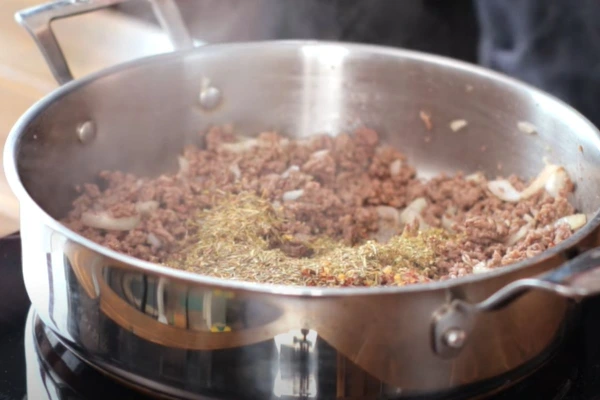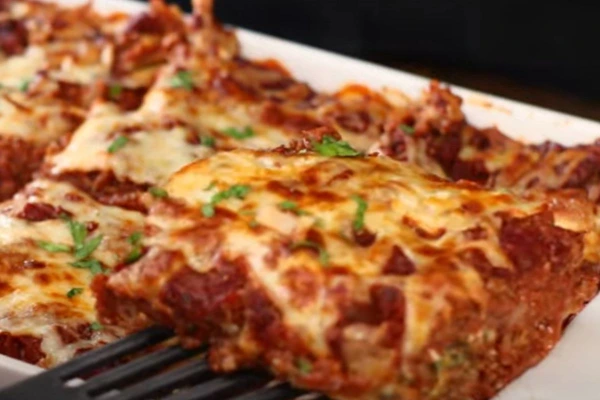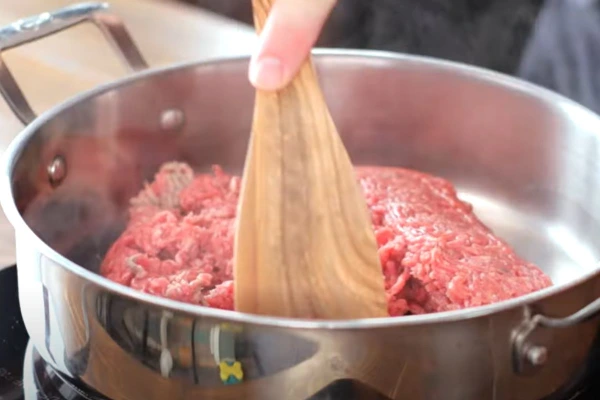Lasagna’s Journey Across Regions
From Italy to the World
Lasagna, with its comforting layers and rich flavors, not only traveled through time but also across the vast landscapes of Italy, adapting and evolving with each region’s unique culinary traditions. This journey highlights how a simple dish can become a global icon, reflective of Italy’s diverse gastronomic heritage.
From Italy to the World
Initially rooted in the ancient and medieval kitchens of Europe, lasagna began its true culinary journey in Italy. Here, it transcended its simple beginnings, with each locality infusing its unique twist. As lasagna spread from the southern regions of Italy to the bustling cities of the north, it embraced local ingredients and cooking styles, transforming into a richer, more varied dish.
Emilia-Romagna, particularly the city of Bologna, is often credited with perfecting the modern version of lasagna we’re familiar with today. Known as lasagna al forno, this version includes layers of rich ragù (meat sauce), creamy béchamel, and Parmigiano-Reggiano cheese, baked to perfection. It’s a testament to the region’s culinary expertise and a staple in what is considered one of the capitals of Italian food.
Regional Variations Within Italy
Beyond Emilia-Romagna, other regions offer their distinctive takes on lasagna, showcasing Italy’s culinary diversity:
- In Campania, lasagna undergoes a transformation during the festive Carnival season, incorporating richer ingredients like ricotta cheese, sausage, and small meatballs.
- Sardinia presents a unique interpretation with lasagne al forno con pane carasau, utilizing thin, crispy bread instead of traditional pasta layers, which adds a delightful textural contrast.
- Liguria favors a pesto-based variation, replacing the heavy meat sauces with a fresher, herbaceous pesto, reflecting the coastal region’s abundant basil and milder flavors.
Each of these variations not only tells the story of lasagna but also of the people and the landscapes from which they come. This regional diversity highlights how local ingredients and traditional techniques can redefine a dish while staying true to its roots.
As we continue to explore lasagna’s rich cultural tapestry in Part 4: “Contemporary Takes and Cultural Debates,” we’ll delve into how modern interpretations and culinary innovations have both honored and transformed this classic dish. Join us to uncover how lasagna continues to evolve and inspire chefs and home cooks around the world.
Contemporary Takes and Cultural Debates
Lasagna in Modern Kitchens: Innovation Meets Tradition
In contemporary culinary circles, lasagna remains a beloved classic, but it has also become a canvas for innovation, reflecting changing tastes and global influences. Today, chefs and home cooks alike experiment with ingredients and techniques, sometimes sparking lively debates about what constitutes “which country invented lasagna“.
Lasagna in Modern Kitchens
Modern interpretations of lasagna vary widely, from vegetarian and vegan versions that use plant-based cheeses and ragùs, to deconstructed presentations that challenge traditional notions of this layered dish. Such innovations are often celebrated for their creativity, yet they can also provoke purists who hold dear the classic Bolognese method.
For example, some chefs incorporate unusual ingredients like truffles or seafood, which, while luxurious, stray far from the original recipe. Others focus on enhancing the traditional recipe with high-quality artisanal ingredients, such as hand-made pasta sheets or slow-cooked, heritage breed meats.
The Great Lasagna Debate: Italy vs. The World
The question of which country invented lasagna often leads to broader discussions about the adaptation of traditional dishes. While Italy is the undisputed heartland of lasagna, many other countries have embraced and adapted the dish, infusing it with local flavors and ingredients. This global journey has sometimes resulted in versions that bear little resemblance to their Italian ancestors, sparking debates among culinary enthusiasts.
These global interpretations, while sometimes controversial, also demonstrate lasagna’s universal appeal and its ability to adapt to different cultural tastes and dietary preferences. Whether one prefers the classic simplicity of the Bolognese version or the creative twists of modern adaptations, lasagna continues to be a dish that inspires passion and enjoyment across the globe.
“Behind the Layers: Ingredients and Preparation,which country invented lasagna” we will explore the essential components that make up traditional lasagna and how they are being reimagined in modern culinary practices. Join us as we delve into the art of lasagna making, from perfecting the ragù to crafting the ultimate béchamel.

Behind the Layers: Ingredients and Preparation
Classic Ingredients and Authentic Recipes
At the heart of traditional lasagna are the ingredients that define its rich, comforting profile. Understanding these classic components not only helps in appreciating lasagna’s culinary depth but also in mastering the dish itself.
Classic Ingredients and Authentic Recipes
The quintessence of traditional lasagna lies in a few key ingredients, each playing a vital role in building its iconic flavor and texture:
- Ragù: A slow-cooked meat sauce, typically made with ground beef or pork, onions, carrots, celery, tomatoes, and red wine. This sauce is the soul of the dish, simmering for hours to develop a deep, complex flavor.
- Béchamel Sauce: A creamy white sauce made from butter, flour, and milk. Its smooth and velvety texture adds a rich creaminess between the pasta layers.
- Pasta Sheets: Ideally, thin and slightly al dente after baking, these sheets are the structural backbone, holding the ragù and béchamel in place.
- Cheese: Parmigiano-Reggiano, grated over each layer, adds a salty, nutty bite, while mozzarella, when used, contributes a delightful stringiness.
Each component is essential, and the quality of ingredients can significantly affect the dish’s final taste and texture. Authentic Italian lasagna emphasizes the balance and harmony among these elements, ensuring that no single flavor overwhelms the others.
Innovative Twists on Traditional Lasagna
- Vegetarian and Vegan Variations: By substituting the ragù with roasted vegetables or plant-based meats and using vegan cheeses and béchamel, chefs create dishes that are both inclusive and flavorful.
- Gluten-Free Options: With the rise in gluten sensitivity, gluten-free pasta sheets have become a popular alternative, allowing more people to enjoy lasagna without dietary concerns.
- Exotic Flavors: Some chefs infuse their lasagna with ingredients like saffron or curry spices, adding a unique twist that sets their dish apart from traditional versions.
These innovations not only demonstrate lasagna’s versatility but also its ability to evolve with changing culinary trends and preferences.
Join us in Part 6: “Frequently Asked Questions About which country invented lasagna ,” where we address common inquiries and provide further insights into making perfect lasagna at home. This section will help clarify any doubts and inspire you to experiment with your own lasagna creations.
Frequently Asked Questions
Lasagna, with its rich history and global variations, often raises questions among culinary enthusiasts. This section aims to address some of the most common inquiries found in the “People Also Ask, which country invented lasagna” sections, providing valuable insights into the preparation and appreciation of this beloved dish.
What are the key steps to making traditional lasagna?
Making traditional lasagna involves several critical steps to ensure that each layer melds perfectly while retaining distinct flavors:
- Prepare the Ragù: Cook the meat sauce slowly to develop a rich, deep flavor. This sauce should simmer for several hours.
- Make the Béchamel Sauce: A smooth béchamel is crucial for adding creaminess. Ensure it’s lump-free by whisking continuously while cooking.
- Boil the Pasta: If using traditional pasta, cook it until it’s just shy of al dente. If using no-boil lasagna sheets, ensure there’s enough sauce to cover them so they cook evenly in the oven.
- Layering: Start with a thin layer of béchamel, followed by pasta sheets, ragù, more béchamel, and a generous sprinkle of Parmigiano-Reggiano. Repeat the layers until all ingredients are used.
- Bake: Cook the lasagna in a preheated oven until the top is golden and bubbly, typically about 45 minutes to an hour.
Can lasagna be made in advance?
Absolutely! Lasagna is an excellent dish for preparing ahead of time. You can assemble it completely and refrigerate it for a day or two before baking. Alternatively, lasagna can also be frozen and baked at a later date. This makes it a perfect dish for meal planning and entertaining.
How can I prevent my lasagna from becoming soggy?
To prevent a soggy lasagna:
- Avoid overlayering sauce, especially if using no-boil pasta sheets, which require more moisture to cook properly.
- Let the cooked lasagna rest for 10-15 minutes after baking. This allows it to set and makes it easier to cut into clean, structured slices.
What variations can I try if I want a lighter lasagna?
For a lighter lasagna:
- Substitute traditional ragù with a lighter vegetable ragù or use leaner meats like turkey or chicken.
- Opt for low-fat cheeses or increase the proportion of vegetables in each layer.
- Consider using a tomato-based sauce instead of béchamel to reduce the overall richness.
Is lasagna suitable for vegetarians?
Lasagna is incredibly versatile and can easily be adapted for vegetarians. Use a rich tomato sauce with a variety of vegetables, such as zucchini, mushrooms, and spinach, in place of the meat sauce. Layer with cheeses and béchamel as usual to maintain its creamy texture.
Embracing the Diversity
As we conclude our exploration into the origins and evolutions of lasagna, it’s clear that this beloved dish is much more than just layers of pasta and sauce. It’s a culinary phenomenon that transcends geographical and cultural boundaries, adapting to the tastes and traditions of wherever it’s made.
Celebrating Lasagna’s Global Appeal
Lasagna has made its way into the hearts and kitchens around the world, each version reflecting local flavors and culinary techniques. From its debated origins in ancient Greece to its codification in Italy and reinvention in kitchens globally, lasagna exemplifies how food can evolve and integrate into various cultures. This journey not only highlights lasagna’s versatility but also its ability to bring people together through shared meals and stories.
The Art of Lasagna: A Unifying Dish
The universal appeal of which country invented lasagna lies in its simplicity and the comfort it provides. It is a dish that celebrates coming together, whether for a festive occasion or a simple family meal. Each layer can tell a story of personal tastes, making lasagna not just a meal but an expression of creativity and culinary art.
Encouraging Culinary Exploration
We encourage you to see lasagna not just as a recipe but as an invitation to experiment and explore. Whether you stick to the traditional layers or venture into more modern adaptations, lasagna offers endless possibilities for customization and innovation.
A Tribute to Lasagna’s Rich Heritage
As we’ve seen, lasagna is more than just food; it’s a piece of culinary history that continues to evolve. By understanding its roots and the many ways it can be adapted, we pay homage to the dish’s rich heritage and its ongoing legacy in the culinary world.
in all its forms, represents the beauty of culinary tradition blended with innovation. As it continues to evolve, it reminds us that food is a universal language, capable of bridging cultures and creating connections.



